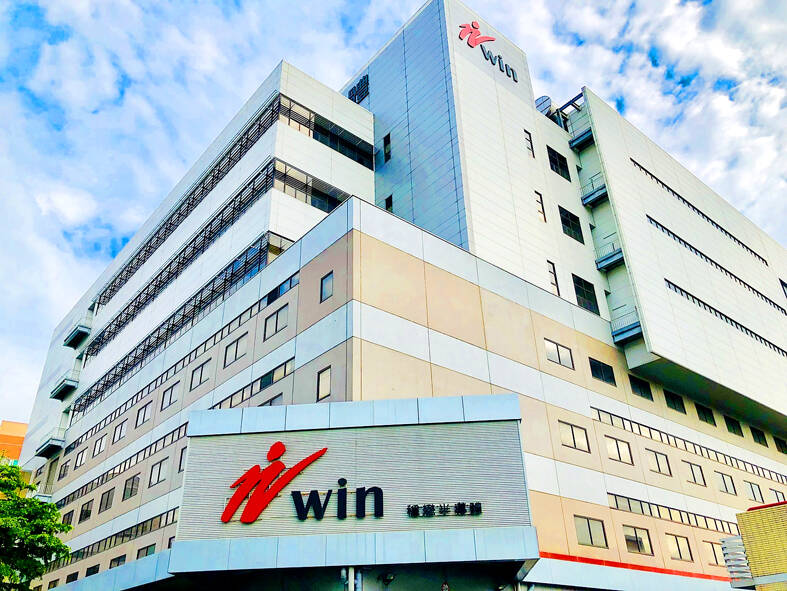Win Semiconductors Corp (穩懋半導體), the world’s largest pure-play gallium arsenide (GaAs) foundry, yesterday said that quarterly losses narrowed to NT$276 million (US$8.78 million), thanks to improving demand from Chinese smartphone makers for new product launches.
That was a significant improvement from losses of NT$479 million in the first quarter, the company said.
Capacity utilization climbed to 40 percent last quarter from 20 percent in the previous quarter, it said, adding that it expects equipment loading to rise further this quarter.

Photo: Screen grab from company Web site
“We started to see nascent signs of an improvement in the smartphone market in the second quarter. We also received more rush orders from Chinese smartphone customers,” Win Semiconductors president Steven Chen (陳舜平) said at an online investors’ conference.
“However, we cannot be certain if that means the year-long inventory correction is coming to an end,” he said.
The company expects revenue to increase by a low-single-digit percentage this quarter from NT$3.94 billion last quarter, as demand for power amplifiers used in smartphones picks up ahead of the introduction of new premium phones.
Gross margin is to drop to about 12 to 16 percent this quarter compared with 20.1 percent last quarter, the company said.
Last quarter’s gross margin outpaced the company’s forecast of a mid-teens percentage, thanks to asset gains, the company said.
An unfavorable product mix is one of the major factors that would lead to lower margins this quarter, Chen said.
Only one segment, power amplifiers used in smartphones, would see an increase in demand, Chen said, as demand for infrastructure, Wi-Fi and optical segments is affected by macroeconomic headwinds.
Power amplifiers made up between 30 and 35 percent last quarter, the biggest revenue contributor to the company, it said.
That was an increase from between 25 and 30 percent in the first quarter.
Infrastructure came next, making up between 25 and 30 percent last quarter.
Wi-Fi made up 15 to 20 percent of the company’s revenue.
Commenting on the company’s new technology advancement, Win Semiconductors said that some customers have adopted Wi-Fi 6E products.
As smartphone vendors and chipmakers have started developing next-generation Wi-Fi 7 products, Win Semiconductors expects that to help boost the company’s revenue due to higher consumption of GaAs.
Asked about growing competition from Chinese peers, Chen said that the company focuses on providing mid-to-high-end GaAs to its Chinese customers, a different segment from the low-end GaAs made by most Chinese manufacturers.
Win Semiconductors has allocated NT$4 billion for capital expenditure this year, slightly lower than last year’s spending.
The company plans to use most of the funds for new facilities and manufacturing equipment at its new plant in the Southern Taiwan Science Park (南部科學園區), it said.

Semiconductor business between Taiwan and the US is a “win-win” model for both sides given the high level of complementarity, the government said yesterday responding to tariff threats from US President Donald Trump. Home to the world’s largest contract chipmaker, Taiwan Semiconductor Manufacturing Co (TSMC, 台積電), Taiwan is a key link in the global technology supply chain for companies such as Apple Inc and Nvidia Corp. Trump said on Monday he plans to impose tariffs on imported chips, pharmaceuticals and steel in an effort to get the producers to make them in the US. “Taiwan and the US semiconductor and other technology industries

SMALL AND EFFICIENT: The Chinese AI app’s initial success has spurred worries in the US that its tech giants’ massive AI spending needs re-evaluation, a market strategist said Chinese artificial intelligence (AI) start-up DeepSeek’s (深度求索) eponymous AI assistant rocketed to the top of Apple Inc’s iPhone download charts, stirring doubts in Silicon Valley about the strength of the US’ technological dominance. The app’s underlying AI model is widely seen as competitive with OpenAI and Meta Platforms Inc’s latest. Its claim that it cost much less to train and develop triggered share moves across Asia’s supply chain. Chinese tech firms linked to DeepSeek, such as Iflytek Co (科大訊飛), surged yesterday, while chipmaking tool makers like Advantest Corp slumped on the potential threat to demand for Nvidia Corp’s AI accelerators. US stock

The US Federal Reserve is expected to announce a pause in rate cuts on Wednesday, as policymakers look to continue tackling inflation under close and vocal scrutiny from US President Donald Trump. The Fed cut its key lending rate by a full percentage point in the final four months of last year and indicated it would move more cautiously going forward amid an uptick in inflation away from its long-term target of 2 percent. “I think they will do nothing, and I think they should do nothing,” Federal Reserve Bank of St Louis former president Jim Bullard said. “I think the

SUBSIDIES: The nominee for commerce secretary indicated the Trump administration wants to put its stamp on the plan, but not unravel it entirely US President Donald Trump’s pick to lead the agency in charge of a US$52 billion semiconductor subsidy program declined to give it unqualified support, raising questions about the disbursement of funds to companies like Intel Corp and Taiwan Semiconductor Manufacturing Co (台積電). “I can’t say that I can honor something I haven’t read,” Howard Lutnick, Trump’s nominee for commerce secretary, said of the binding CHIPS and Science Act awards in a confirmation hearing on Wednesday. “To the extent monies have been disbursed, I would commit to rigorously enforcing documents that have been signed by those companies to make sure we get